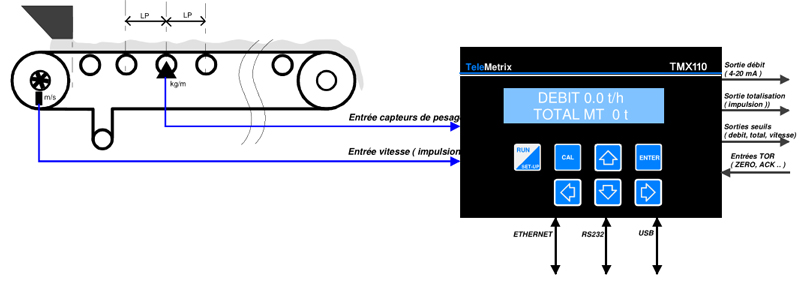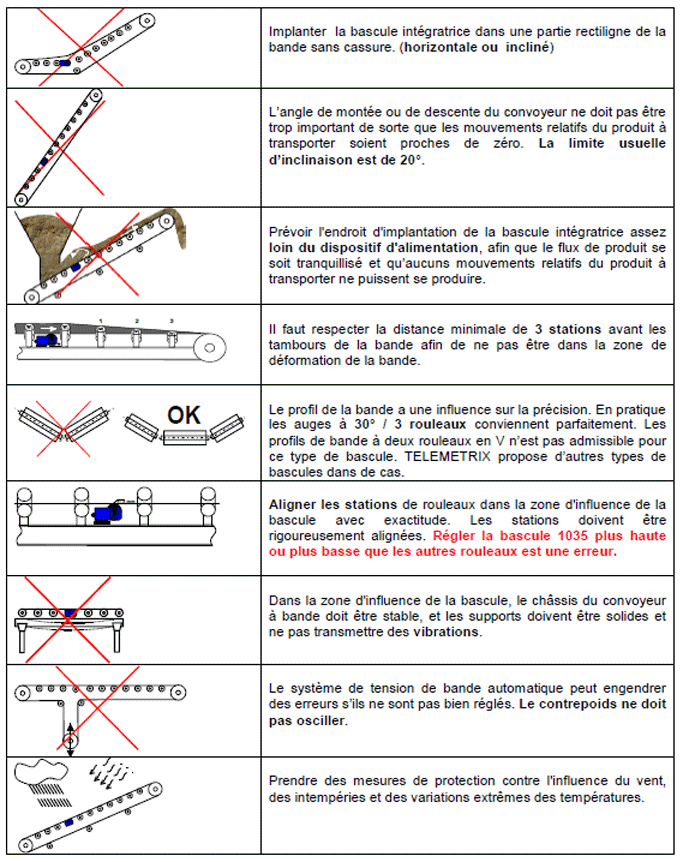Guide For Implementing Conveyor Belts Scales
Guide For Implementing Conveyor Belts Scales

PRINCIPLE
Dynamic weighing or continuous weighingis used to calculate the flow of an uninterrupted stream of material. This continuity of charge constitutes the main difference with the previous modes. Due to the displacement of the load, the weight to be measured constantly varies on the weighing table and the continuous weigher will integrate these variations in weight over time, hence its name of integrating scale. As a corollary, any continuous weighing system measures the weight but also the speed of movement of the product. This is the case, for example, with belt scales, weighing screws or scales called “with conveyor included”. Continuous instruments are defined by their capacity in tonnes / hour (t / h) and their precision which is expressed in relative value and no longer in absolute value. For example: T12 - All-round scale - 900 t / h +/- 1%. The integration of the weight makes it possible to accumulate the past tonnes and explains that a continuous indicator is called Continuous Totalizer. In regulated use, it falls into the category of IPFA.
Discontinuous weighing is halfway between static weighing and continuous weighing. Like continuous weighing, it performs on-line weighing, its precision is expressed in +/-% and not in absolute value, and it accumulates the weighed weights. Like static weighing, the load is stationary at the time of weighing and the weight is measured at stability achieved. It therefore has the advantages of both types of weighing: high precision of static weighing and uninterrupted material flow of continuous weighing. In practice, it creates a momentary interruption of the flow to carry out its weighing. For this, it needs a buffer hopper upstream and downstream of the scale. In other words, it requires a weighing tower. Because of this heavy investment, discontinuous weighers, commonly known as "circuit scales", are especially suited to high value products or high throughputs such as the loading of phosphate ships. However, their use in quarry remains ad hoc.
TELEMETRIX also masters a weighing solution in the case where the conveyor is bidirectional.
COMPONENT OF AN INTEGRATING BELT WEIGHER
- A weighing infrastructure (load receptor) made up of one or more roller stations.
- A speed sensor, also called an odometer, which measures the distance traveled by the strip between each measurement.
- Electronic processing and control equipment called weighing integrator.
Load receptor - weighing table
Depending on the constraints: belt speed, flow, grain size, precision, the load receptor is made up of 1, 2 or 4 weighing cells. It is important that it is installed in a stable place on the conveyor where the product is at the same speed as the belt.
Speed sensor
The speed sensor is an important element when looking for an accuracy better than 1%. Our electronics are able to support 2 speed sensors simultaneously in order to obtain a diagnostic function of the speed sensor (comparison between the two measured speed)
Weighing integrator
The processing electronics is an important element, it includes a fast calculator integrating the weighing according to the distance traveled. The integrator thus provides the following information:
- Speed (in m / s or m / min)
- Flow (t / h or kg / h)
- MT perpetual totalizer (kg or t).
- Partial totalization RT (kg or t) up to 3 registers with independent reset
- Load or meter (kg / m)
Various alarms on the operation of the integrating scale.
INFORMATION NEEDED TO DEFINE A BELT WEIGHER
CONVEYOR TECHNICAL DATA
Existing conveyor YES NO
Belt width 650 to 1600 mm Belt
profile: Trough 15 20 25 30 35 45 °
Material: Grain size:
Rollers 60 89 133 mm
Distance between stations 1.0 m Other:
Belt speed ______ m / s
Slope ______ °
Frame: Conveyor integrated into the supporting frame.
WEIGHING ON BELT
Number of stations weighed 1 2 3 4
Nominal flow (Qn) ____ t / h kg / h
Maximum flow 120% of Qn
Minimum flow 20% of Qn
Accuracy 0.25 0.5 1 2%
Analog output (flow) 4-20 mA YES
Pulse output (total) YES NO
Digital output MODBUS TCP WEBSERVER PROFIBUS PROFINET ETHERNET IP
Report YES: EXCEL file on USB key and EMAIL (XSCALES)
RECOMMENDATION FOR INSTALLATION OF A BELT WEIGHER



